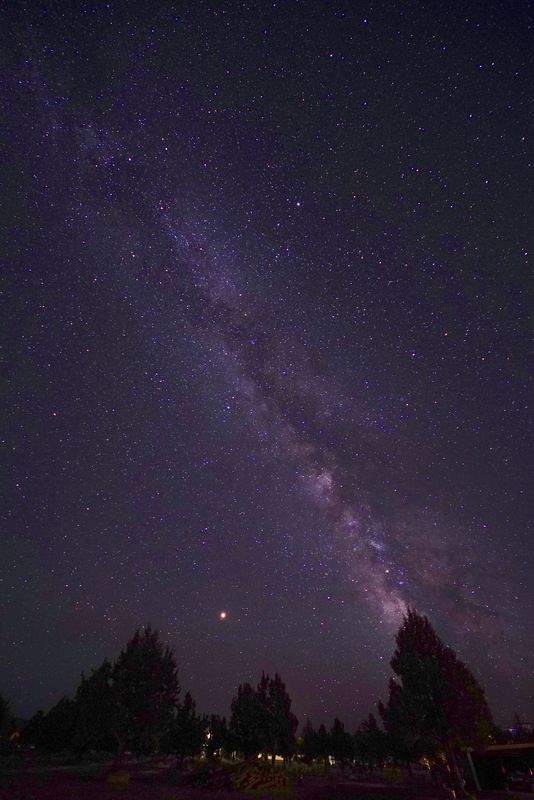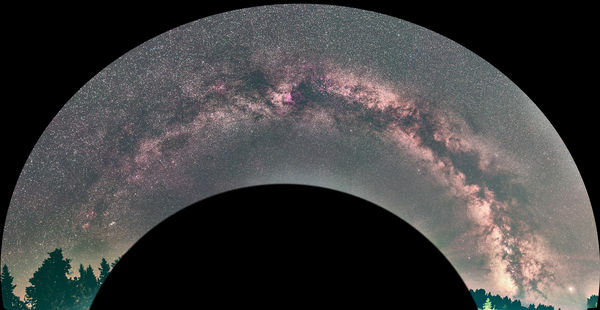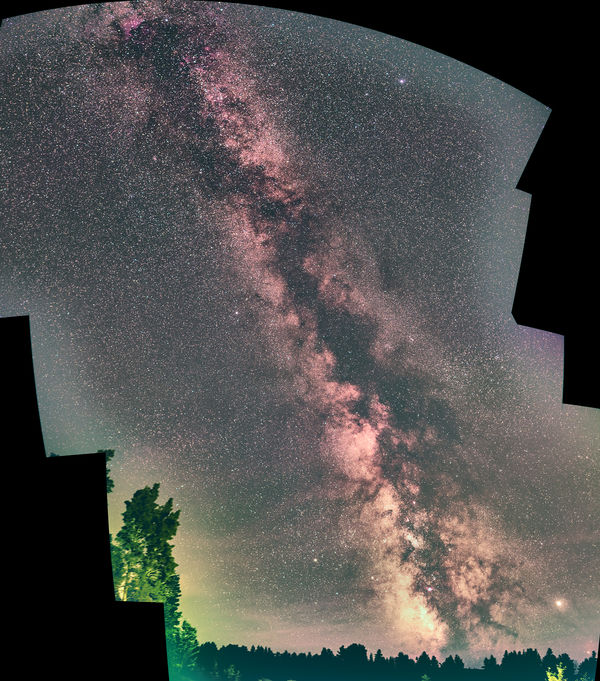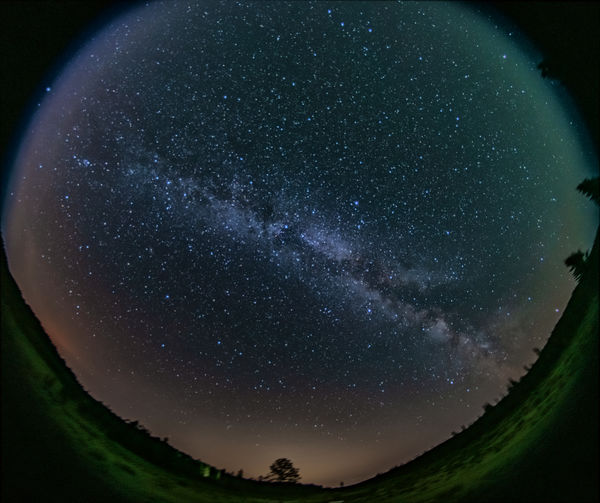New with Astophotography Questions
Aug 7, 2019 13:56:20 #
OleMe
Loc: Montgomery Co., MD
The Introduction: I've been reading and enjoying for a few weeks. Even posted a few replies. My loves are my Linux computer and travel, with attendant photography. I've sold a lot of more bulky equipment and am making the BIG MOVE to Micro 4/3rds, most likely an Olumpus OMD E M-10 Mark III. I want a Olymput Pen-F but will likely settle for more bang for the buck. I'm preparing for a trip to Big Bend Natl. Park, RV-ing w/ my brother, in Sept / Oct. That's Little Ole Me in suburban Washington, DC.
QUESTION: Note: I'm primarily after images of the Milky Way. I've read about the 500 rule / rule-of-thumb for avoiding star trails. My understanding is that applies to 35mm camera lenses. Hos about micro 4/3rds? Say a 28 mm lens, which in my case is probably ~ 1.6 x 28 or ~49 mm equivalent for a 35 mm camera. I've got a choice of a 28 or 45 mm lens, both F/2.8. Which would be best for Milky Way?
FWIW: I've read several on-line guides, including Night Photography: How to Photograph The Night Sky, by Dave Morrow.
Thanks. /Roger
QUESTION: Note: I'm primarily after images of the Milky Way. I've read about the 500 rule / rule-of-thumb for avoiding star trails. My understanding is that applies to 35mm camera lenses. Hos about micro 4/3rds? Say a 28 mm lens, which in my case is probably ~ 1.6 x 28 or ~49 mm equivalent for a 35 mm camera. I've got a choice of a 28 or 45 mm lens, both F/2.8. Which would be best for Milky Way?
FWIW: I've read several on-line guides, including Night Photography: How to Photograph The Night Sky, by Dave Morrow.
Thanks. /Roger
Aug 7, 2019 14:00:08 #
OleMe wrote:
The Introduction: I've been reading and enjoying f... (show quote)
Take your questions here: https://www.uglyhedgehog.com/s-109-1.html That is the sub-forum for Astronomical photography here on UHH. They will know more.
Aug 7, 2019 14:20:35 #
Aug 7, 2019 14:41:42 #
No matter what format you use, go for the widest lens you have. You may consider a super-wide by Samyang or equivalent. These are very reasonably priceed in the fully manual lens. Fully manual lens is actually what you want for star photography, Af will not work, so you will be manually focus and you will be shooting wide open anyway. You may also consider renting a lens. I would consider something between 8 and 10mm for you camera. I use a Samyang 14mm f2.8 on my full frame camera for night shots.

Aug 8, 2019 06:37:38 #
OleMe wrote:
The Introduction: I've been reading and enjoying f... (show quote)
FYI, haven't done any astrophotography but since you're going to the Big Bend area, try & schedule a trip to the McDonald Observatory in Ft Davis, near Alpine, TX. We stop there everytime we drive through TX and enjoy their Star Shows. Its also at about 8000' elevation and excellent for clear nights.
Aug 8, 2019 06:43:36 #
You are going to want as wide an angle of view as possible both to get more of the Milky Way into the image but also to lengthen your exposure time. A shorter exposure time which comes with a longer focal length equals a higher ISO which will be a problem with a very small sensor
Aug 8, 2019 07:58:08 #
OleMe wrote:
The Introduction: I've been reading and enjoying f... (show quote)
Love Big Bend, you will be amazed at how dark it can really be. Like being outdoors in a photo lab darkroom.
You may find this article helpful. The rule of 500 is changing, but MFT camera would be Rule of 200 according to them. Me? I just use Photo Pills app. Best $10 you will ever spend.
Have a great trip!
https://www.nationalparksatnight.com/blog/2019/4/13/new-rule-for-shooting-the-sharpest-stars-in-the-sky?utm_term=0_5fe0716fe0-70329fcdfa-110832761&mc_cid=70329fcdfa&mc_eid=c6acf03266
Aug 8, 2019 09:05:04 #
AirWalter
Loc: Tipp City, Ohio
OleMe wrote:
The Introduction: I've been reading and enjoying f... (show quote)
Have you been to the web site for "Photo Pills". They seem to specialize on this subject and there is a wealth of information on their site. Good luck and Happy shooting.
https://www.photopills.com/
Aug 8, 2019 11:07:45 #
OleMe
Loc: Montgomery Co., MD
Blaster34 wrote:
FYI, haven't done any astrophotography but since you're going to the Big Bend area, try & schedule a trip to the McDonald Observatory in Ft Davis, near Alpine, TX. We stop there everytime we drive through TX and enjoy their Star Shows. Its also at about 8000' elevation and excellent for clear nights.
Thanks for the tip. A ranger in the Park also recommended the observatory.
Aug 8, 2019 11:14:33 #
OleMe
Loc: Montgomery Co., MD
Great advice from a LOT of people. Photopills: whatta site! You all are helping to elevate my level of excitement.
Aug 8, 2019 11:17:45 #
fetzler
Loc: North West PA
You will want a a wide angle lens with at least f2.8 aperture. The 12mm Olympus lens would be OK. I picked up a 7 artisans 7.5mm f 2.8 fisheye lens. It is NOT a circular fisheye but rather the image is frame filling. While the lens is not rectilinear some of found to be useful for your purposes. The images can be defished with software (imadio is good) if necessary but you probably won't need to. I will post some images later under anther topic. The lens I mention costs $139.
Aug 8, 2019 11:38:32 #
This is probably over-kill, since you've already done research, but here are a lot of links about star photography.
https://www.wikihow.com/Photograph-the-Night-Sky
https://www.lightstalking.com/bite-size-tips-build-workflow-post-production/
http://makezine.com/projects/how-to-capture-breathtaking-time-lapses-of-the-night-sky/
http://www.popphoto.com/how-to/2013/06/how-to-shoot-epic-landscape-photos-night-sky
http://photography.nationalgeographic.com/photography/photo-tips/night-sky/?sf4138099=1
http://iso.500px.com/a-day-in-the-life-of-astrophotographer-aaron-groen/?utm_campaign=nov132014digest&utm_content=CTAbutton_aaronjgroen_500pxProfilepage&utm_medium=email&utm_source=500px
http://www.picturecorrect.com/tips/tips-for-post-processing-your-constellation-photos/
http://petapixel.com/2014/01/29/picking-great-lens-milky-way-photography/
http://www.borrowlenses.com/blog/2013/05/the-best-lenses-for-night-photography-a-case-for-rokinon-primes/
http://www.picturecorrect.com/tips/star-trail-photography-tips/
http://photography.tutsplus.com/tutorials/how-to-set-up-your-digital-slr-for-night-photography--cms-24099
https://www.wikihow.com/Photograph-the-Night-Sky
https://www.lightstalking.com/bite-size-tips-build-workflow-post-production/
http://makezine.com/projects/how-to-capture-breathtaking-time-lapses-of-the-night-sky/
http://www.popphoto.com/how-to/2013/06/how-to-shoot-epic-landscape-photos-night-sky
http://photography.nationalgeographic.com/photography/photo-tips/night-sky/?sf4138099=1
http://iso.500px.com/a-day-in-the-life-of-astrophotographer-aaron-groen/?utm_campaign=nov132014digest&utm_content=CTAbutton_aaronjgroen_500pxProfilepage&utm_medium=email&utm_source=500px
http://www.picturecorrect.com/tips/tips-for-post-processing-your-constellation-photos/
http://petapixel.com/2014/01/29/picking-great-lens-milky-way-photography/
http://www.borrowlenses.com/blog/2013/05/the-best-lenses-for-night-photography-a-case-for-rokinon-primes/
http://www.picturecorrect.com/tips/star-trail-photography-tips/
http://photography.tutsplus.com/tutorials/how-to-set-up-your-digital-slr-for-night-photography--cms-24099
Aug 8, 2019 12:51:54 #
ORpilot wrote:
No matter what format you use, go for the widest l... (show quote)
I wouldn't go widest, but on an M4/3, I would go pretty wide because of the 2x crop factor. Max aperture is a critical consideration also.
Personally (and I'm far from alone, as even a Lonely Speck guide agrees), on my full frame camera I much prefer my Samyang 24mm f/1.4 (of course I would prefer the Sony 24mm if I could justify it). It's a narrower lens compared to a 14mm, but it draws in the MW nicely to make it a dominant feature of any photo. And if the lens isn't wide enough for a particular shot, I'll shoot a few frames to stitch later in Photoshop. I own an the ultrawides Samyang 14mm f/2.8 and 12mm f/2.8 "fisheye" (called fisheye but it doesn't distort ore than a rectilinear) also, but the 12mm is really too wide to the point that the MW becomes an afterthought, barely recognizable in a photo. I wouldn't recommend wider than a 14mm equivalent.
Aug 8, 2019 16:36:25 #
My suggestion is to use the widest lens for the Milky Way. Big Bend is one of the darkest places in the South. You will be dazzled by the night sky. I also have that opportunity here in Las Vegas just 1.6 hours away and well worth the time. You have figures out the equivalent lens size relative to the standard 35 mm full frame camera. Use that OR try using the "300" rule where instead of converting everything, just divide 300 by the lens size. Eg. 300/28 = about ten seconds of exposure. This has nothing to do with exposure, just star trails. Exposure is an experimental value that is determined at the time of exposure. Rely on your histogram for exposure. Keep the humps on the left third of the histogram and away from the edges. Good luck and clear, dark skies for you. If you want to talk more, give me a PM. RFB
Aug 8, 2019 18:04:38 #
OleMe wrote:
The Introduction: I've been reading and enjoying f... (show quote)
As opposed to a number of other posters, I like a somewhat longer lens (35-50mm) and create Milky Way panoramas / mosaics, although every once in a while I do use a 6.5mm fisheye. I find a longer lens provides more detail.
Your 28 or 45mm will work just fine!
bwa
Milky Way (127x10sec.@ISO1600)_ABE-35mm-Little Planet-Perspective

(Download)
Milky Way(48x10sec.@ISO1600)-35mm_ABE-South

(Download)
Milky Way (10x20sec.,ISO 3200)-6.5mm

(Download)
If you want to reply, then register here. Registration is free and your account is created instantly, so you can post right away.




